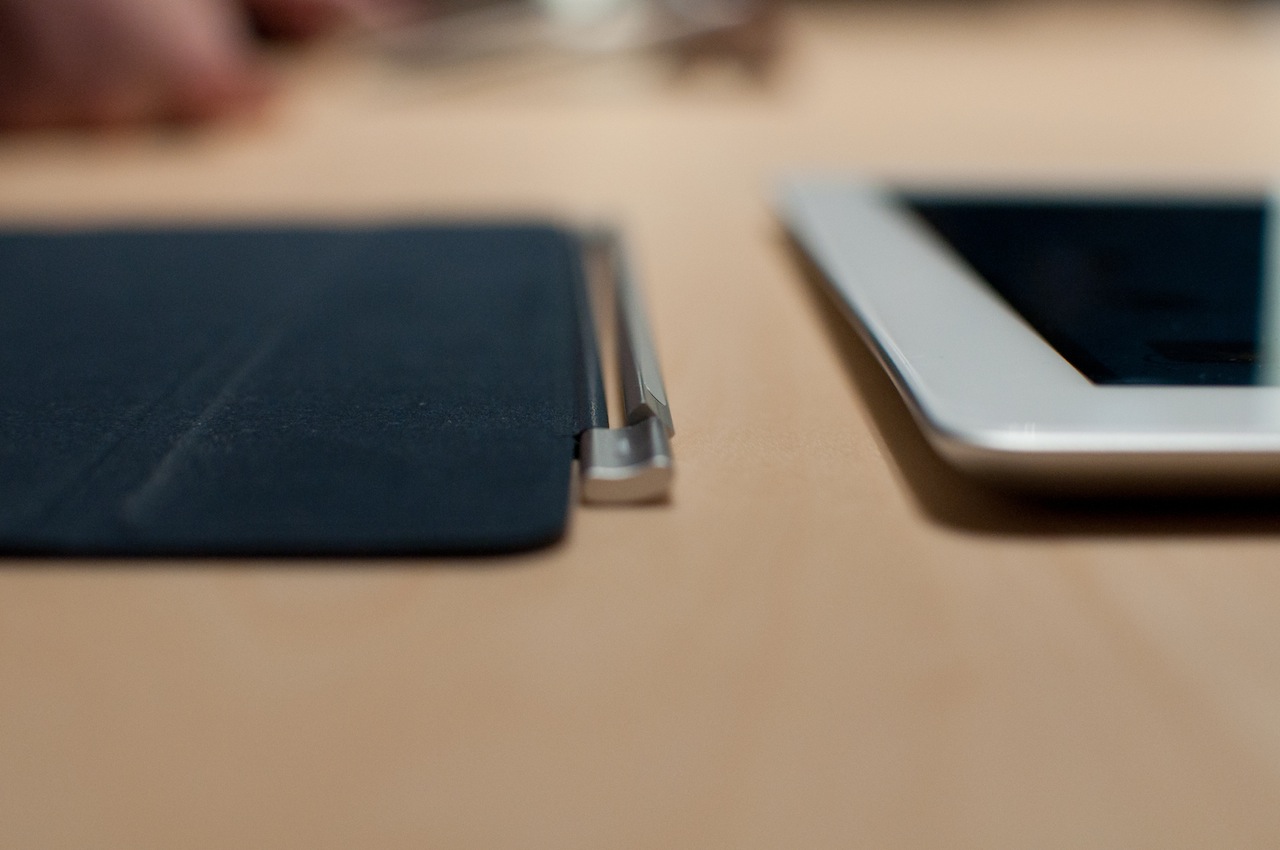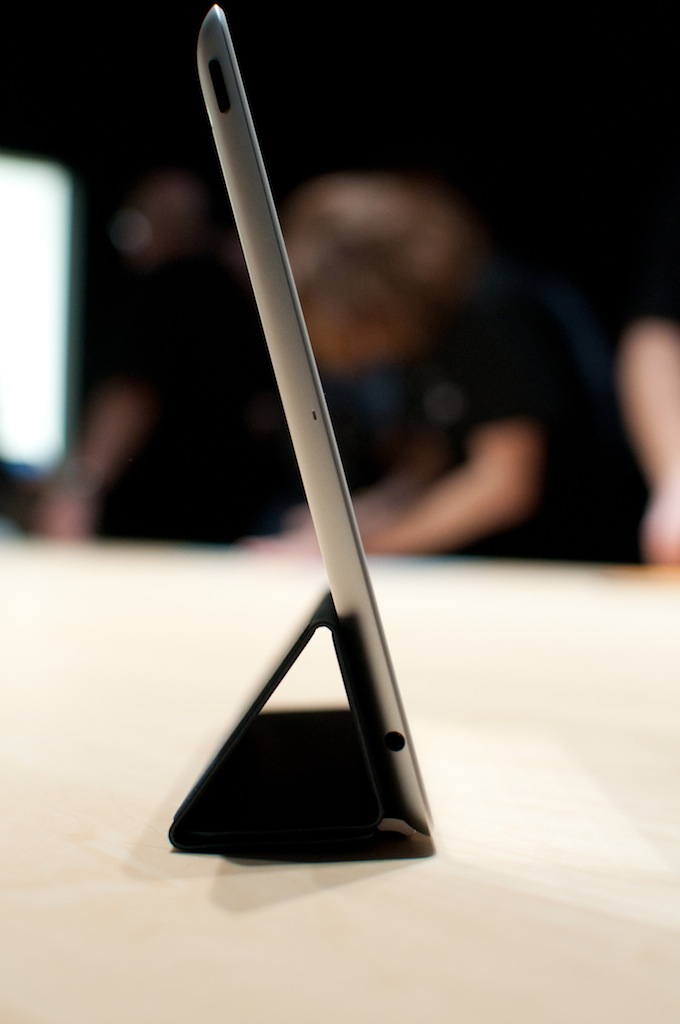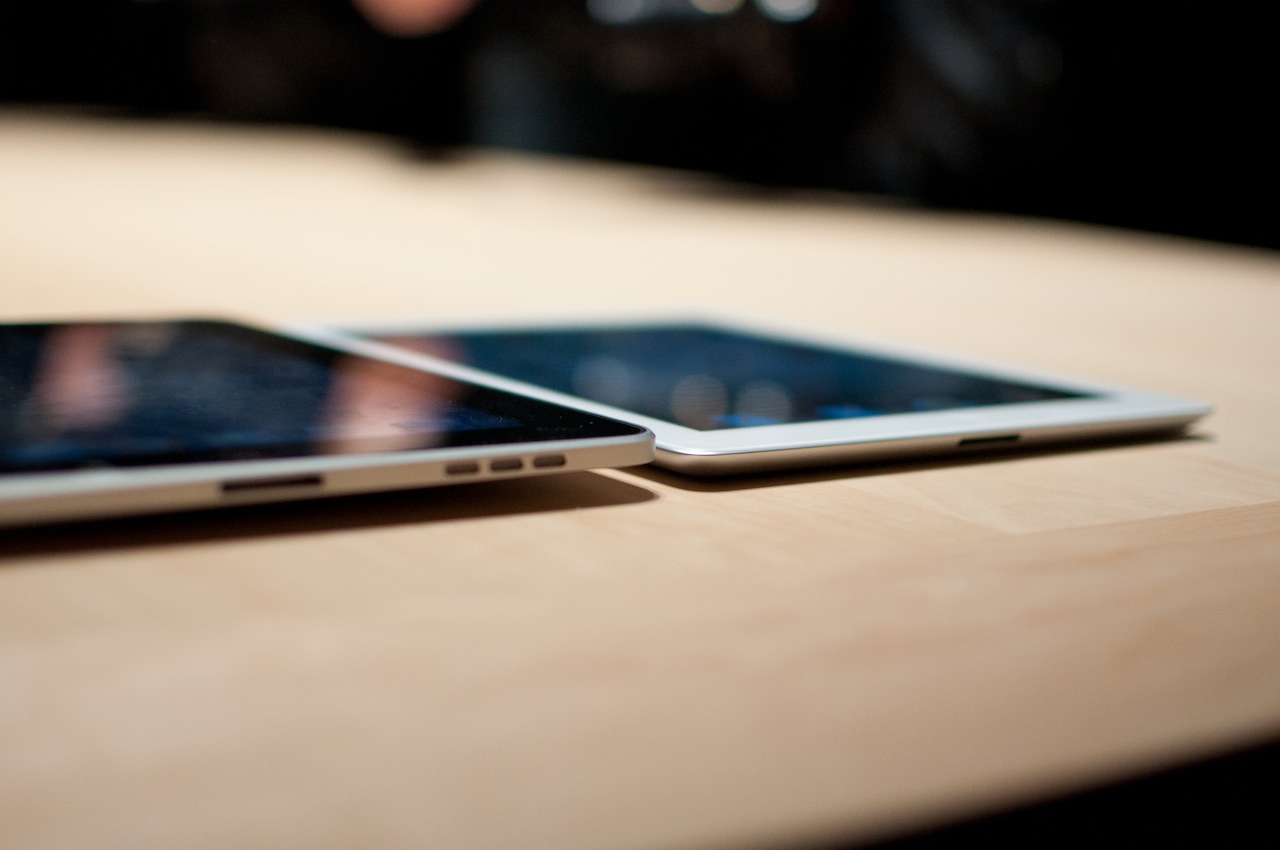Hands-On Details about the iPad 2 and iOS 4.3
If you thought the iPad was too heavy and bulky before, just wait until you hold it next to the new iPad 2. I was on hand for Apple’s March 2nd announcement and spent time working with the new device, got a feel for the cool new Smart Covers, and learned several details that didn’t make it into Steve Jobs’s presentation. (See “iPad 2: Faster, Thinner, Lighter, and Bicameral,” 2 March 2011.)
Smart Covers — Nearly as much presentation time was devoted to Apple’s new Smart Covers for the iPad 2 as to the iPad 2 itself, and I can understand why. They’re really cool. I’ve used Apple’s black iPad case on my first-generation iPad not because it’s especially stylish — it’s not — but because it’s thin and functional. I’d prefer to have the iPad out by itself, but I found that carrying the iPad with no case at all is awkward: I didn’t want to hold it sideways like a notepad and smudge the screen, so I was always self-conscious about it. With the black iPad case, the screen is covered, and I can grab it however I choose, tuck it under an arm if
needed, and slide it into my bag without worrying about scratching the screen.
The new Smart Covers appear to do all that in the most minimal possible way. Magnets in the metal hinge connect to magnets along the inside of the left edge of the iPad and snap securely in place. The attractive and durable-looking covers are made either of leather or polyurethane (“which is used to make spacesuits!” exclaimed Jobs). The leather covers are nice, thin, and tactile; I didn’t immediately notice that an iPad handed to me was using the leather cover versus the polyurethane, although to be honest I was more focused on the iPad itself.
Are the covers worth $39, or $69 for the leather versions? I think so, but it will be interesting to see what third-party case manufacturers come up with once they get the specifications on where to place the magnets. I will definitely buy a Smart Cover to go along with my iPad 2, but haven’t yet decided if I’ll spring for the leather version. Apple also notes about the leather covers on the product page, “Some color may rub off
during use.”
Speaking of third-party covers, the iPad 2 includes a system preference to enable the sleep/wake functionality that kicks in when the cover is closed and opened. It’s a great additional feature, and was nicely responsive in my repeated flipping of the cover’s edge.
The way the Smart Cover bends in four places is also quite clever and quite useful. (Click and drag the sample on Apple’s site to see how this works.) I regularly flip back the cover of my black iPad case and latch it to hold the iPad at an angle. In fact, setting up the Smart Cover in the vertical orientation felt more stable to me than the old iPad cover, which often feels tippy because the base can sometimes bow slightly.
The Feel of a New Machine — For several people I know, the size and weight of the first-generation iPad is a detriment; it’s just heavy enough that holding it for long periods of time — even propped against a leg; I’m not talking about elevating the iPad for hours — is tiresome.
(Let’s take a moment and point out that the original iPad is still much thinner and lighter than tablets that came before, so Apple gets credit for that. However, the reality is that we like our technology thinner and lighter than what came before, no matter the dimensions of the previous device.)
I didn’t get a good sense of how much the weight differed; it’s only 3.2 ounces (90 grams), after all. But the thinness is wonderful, and contributes to the sense that the iPad 2 is lighter than it really is. Your brain sees a sliver of glass and aluminum. Not a slab. Not a slate. And I think that physical effect will be lasting, just as I notice how much sturdier my unibody MacBook Pro is compared to old models every time I pick it up.
FaceTime — After months of speculation that the iPad 2 would include dual cameras, the presence of FaceTime isn’t a surprise. The image quality looked soft in the hands-on room at the event, partly due to the VGA-resolution front-facing camera, and perhaps partly due to a room full of FaceTime demo chats going on. But I’m willing to give it a chance; FaceTime on the iPhone 4 has been great for doing video chats between my daughter and my mother (who uses FaceTime on the Mac), more so because Grandma is on a satellite Internet connection. In fact, the FaceTime image quality is consistently better than iChat video. FaceTime is still limited to Wi-Fi networks.
Faster Mobile Broadband — Hidden in the iPad 2 announcement was a speed bump, although the implications still need to be measured. The 3G GSM (AT&T-compatible) iPad 2 joins the GSM iPhone 4 as the first models in each line to support the faster upload speeds possible with HSUPA, an upload standard for 3G GSM networks. The iPhone 3G and 3GS and original 3G iPad included only UMTS for upstream traffic, which maxes out at 384 Kbps. HSUPA in the flavor used in the iPhone 4 and likely in the iPad 2 can reportedly hit 5.8 Mbps of raw throughput, although AT&T’s network is limited to somewhat under 2 Mbps. Carriers in some other countries are running faster networks,
and AT&T will eventually upgrade its upstream rates to that level.
On the download side, there’s no information from Apple yet about whether the iPad 2 improves on the 7.2 Mbps downstream flavor of HSDPA that’s built into the iPhone 4 and the original 3G iPad. AT&T built this rate out to cell towers nationwide, and is now working a boost called HSPA+, which offers a raw throughput of 21 Mbps. It’s possible HSPA+ is in the iPad 2, but AT&T said late last year that it only expected to see tablets with HSPA+ by the second half of 2011. In practice, 7.2 Mbps HSDPA can top 4 Mbps in the real world, and 21 Mbps HSPA+ might provide sustained download rates of 8 Mbps in the right conditions.
The Verizon Wireless CDMA flavor of iPad 2 remains fixed on Verizon’s current 3G standard, EVDO Rev. A, which the company is working to enhance by rolling out a faster standard called LTE. AT&T will also launch LTE this year. Neither 3G model of the iPad 2 will have LTE connectivity, but nor does any laptop on the market. Motorola recently flabbergasted many of us by explaining that its Xoom tablet, which is upgradable to support LTE, will require six days at a factory to install a new modem when the upgrade becomes available in a few months. LTE might offer 5 to 12 Mbps downstream, but it will take until 2013 for nationwide LTE coverage to overlay today’s GSM and CDMA 3G networks.
iMovie and GarageBand — I’m excited to start playing with the new version of iMovie for iOS, which will be available on the iPad 2, iPhone 4, and camera-equipped iPod touch. I’m also curious to see how Apple translated the new version and features to the latter two devices with their smaller screens.
Contrary to earlier reports, I confirmed late in the day that iMovie will not be available for the first-generation iPad. My guess is that there are two culprits: The original iPad does not include a camera, and even though I can see how it would be helpful to import footage and edit it on the iPad, Apple likes to have all features available for an app like iMovie. The second reason, I suspect, is memory. The iPhone 4 contains 512 MB of RAM, and the iPad 2 must contain at least that much (although the fourth-generation iPod touch is equipped with 256 MB of RAM, and is supported). Apple is extremely reluctant to reveal how much RAM is in the iPad, despite the fact that we’ll learn that fact as soon as someone like iFixit buys one of
the first units and tears it apart.
GarageBand for iOS, the other major software announcement, also looks extremely polished and fun, although not being a musician, it doesn’t grab my interest as much. I do appreciate that a significant amount of effort has gone into appealing to people who would otherwise skip a music app like this. Also, based on the large number of music-related iPad apps and accessories at Macworld Expo last month, there must be a market out there. Or, at least a lot of people who like to burn money developing and trying to sell music gear.
Unlike iMovie, GarageBand will run on the first-generation iPad, although, I presume, with limited performance. Also, projects you create on the iPad can be transferred to the Mac, where you can continue editing (following an upcoming GarageBand ’11 update). It’s a one-way street, however; you can’t go back and forth, or start on the Mac and finish on the iPad. But I imagine it’s a great way to noodle with musical ideas when inspiration strikes, and then polish them when you’re back at your desktop computer.
A Few Other Tidbits — The HDMI video adapter for mirroring the iPad’s screen on an HDTV or HDMI-capable projector is a great addition, but I also learned that the same feat can be accomplished using Apple’s existing iPad VGA Adapter, making it possible to connect the iPad to older projectors and displays. Apparently, there’s nothing specific to the HDMI adapter that makes mirroring possible; it’s the graphics capability of the A5 processor in the iPad 2. An original iPad can use the HDMI connector, but only with specifically enabled apps and features that already play through dock connector adapters.
A part of the iOS 4.3 update, iTunes Home Sharing lets you stream media from a copy of iTunes on your network to your iPad, rather than having to first transfer it during a sync operation. In addition, Home Sharing helps keep your library up to date. When you purchase a song on an iOS device and then connect to your iTunes library wirelessly, the song is automatically transferred to your library. It’s like turning your iOS device into an Apple TV.
Lastly, I recommend watching Apple’s video of the event to see Steve Jobs in fine form. I’m not talking about his health (he looked about the same as he did at Apple’s October 2010 event, like a man dealing with illness but not debilitated), but rather his criticisms of the rest of the tablet market. I believe Jobs is genuinely surprised that Apple is so far ahead of the game, that every other major player is just getting ramped up to compete with last year’s iPad. If you want to get a sense of Jobs’s and Apple’s competitive nature, the first few minutes of the presentation provide a telling glimpse.



I was really hot for the Xoom until I saw the iPad 2 yesterday. One of my peeves about the iPad is having to use iTunes to sync -- I find iTunes really intrusive -- but the iPad 2 will make me swallow my distaste for iTunes. The Xoom is (relatively) too heavy and the Android Market offers only a few worthwhile apps and a lot of unproven junk. A question: I have a lot of "paid for" apps and books on my current iPad -- how do I get them transferred to the iPad2?
All your current apps and books can be synced to iTunes from your current iPad, and then easily synced to your new iPad. No problem. In fact, they should download to your computer whenever you connect your current iPad, unless you've changed settings.
If you're using the same iTunes account to sync the iPad (v1) and the iPad v2, the apps are still available for installation on the new iPad.. You will not have to re-pay for the same apps again.. I've done this with the iPhone several times and it's a no-brainer. Apple's thought of this issue and it just 'works'!
While I don't dislike iTunes, I have to avoid it because my new iPod touch requires a newer version of iTunes than my current Mac supports.
You can minimize the "pain" by only doing major syncing via iTunes once in a blue moon by using Dropbox to sync files and MobileMe to sync contacts, calendars, and email.
I can go weeks at a time without syncing.
As an educator and presenter, I believe video mirroring is the most valuable new feature. We agree that the existing VGA adapter should work and that mirroring will likely be limited to iPad 2. More on this at ipadacademy.com - iPad 2: The Best New Feature for Teachers, Presenters & Trainers? Video Mirroring!
The Portable Prof™
ipadacademy.com
Nice article, Jeff. I'll be interested to see the speed improvements, notably in Safari, not that I ever had to wait long (on WiFi anyway) with the first generation. Hard to see how ANY other manufacturer can make a dent in this market. AAPL should have a strong year.
According to one Apple staffer I spoke with, the Safari improvements should be significant. Not just due to the JavaScript engine, but because the dual-core A5 does a good job of splitting up load tasks: one core handles text/HTML, the other core handles images, etc.
Thank goodness for iTunes ... it really puts every alternative in the shade.
I will be queuing for the iPad2, it is a complete knockout! The sheer speed of it looks brill !!
Do I understand correctly that with the new iPad you will be able to access 3G with the non-3G model via wi-fi through your iPhone? If so, will this add extra cost to your AT&T 3G plan or will AT&T simply charge for the total data used by both units?
Not really. You can use the iPhone 4's Personal Hotspot feature (which will be part of iOS 4.3 when it's released on March 11) to set the iPhone as a Wi-Fi base station. Then, on your iPad (any iPad, not just iPad 2), you connect to the iPhone's Wi-Fi network. That way, you access the Internet using the iPhone's cellular data connection.
You pay extra for the Personal Hotspot feature, which will have a maximum bandwidth allotment. And because the iPhone is a hotspot, you can connect any device (such as your computer) to the Internet via Wi-Fi.
So that sounds like a yes, not a no. I don't see why I would need a 3G iPad; a wi-fi only one should be just as good as long as I have my iPhone handy to act as a hot-spot.
Um, yes. Just not precisely how you described.
The question for me will be: how much of a hassle will it be to enable the personal hotspot and connect with the iPad, especially if you just want to look something up? I suppose if you'll do it, you plan on being connected for a while. But the advantage of the iPad 3G is just having net access immediately. Oh, and getting notifications (if you get any on the iPad anyway).
I agree it would be extra bother. The reason I'm considering it is to save the money on the 3G which I currently have on my iPad 1 and have found that I only rarely use. I'm almost always in areas covered by wi-fi so maybe it isn't worth spending the extra 100+ bucks.
Are there any other sacrifices I'm ignoring? Once I make a purchase there's no turning back. ...Until the iPad 3 comes out, that is. (grin)
The Wi-Fi only model does not have a GPS chip, although the iPad can do a decent job locating itself based on nearby Wi-Fi networks.
I have a Verizon Mi-Fi device. Can also connect via USB ... will Camera connection kit allow a working connection? Wi-Fi works, but battery life is about 4 hrs.